As you all know, we have seven wonderful cats who are all indoor/outdoor cats. Unfortunately, cats are known to be curious. We’ve had issues with some of our cats disturbing our neighbors. Well Kati and I decided that if we want to keep the peace in our neighborhood, then we are going to have to find a way to contain our cats to our yard. However, this is not an easy task. After searching online for different ways to keep our cats in our yard we found the Purr…fect Fence.
There were two options, the free standing kit or the conversion kit. The conversion kit is much cheaper, but it requires an actual fence. We considering getting a privacy fence and buying the conversion kit, but this would have been a much pricier and much harder task. So we opted to purchase one free standing kit. You cab order online but I had a few questions first. So I called them directly. It seems like a pretty small operation; the guy I spoke with was extremely nice. He was very helpful with my questions. I would have felt comfortable calling him back for anything else.
I did not document putting the fence up the way I wanted to. But it is actually pretty easy. There are several components to the free standing kit. The first thing I did was measure, measure, and measure again. You are suppose to put the poles at a maximum of 14 feet apart. Butted up against the house, we were able to get a 40′ x 28′ area for the cats to call their own.
Tools I used:
- Measuring Tape
- Hammer
- 8lbs. Maul (I think this actually worked out better than a normal sledge hammer would have)
- Drill (actually go to buy a new one for this project)
- Tin Snips
- Muscles
- Brain
- Step Ladder (for drilling the u-brackets)
- Flags (for marking where I wanted to drive the pole inserts)
I would recommend (but did not use):
- Stanley Hog Ringer
Putting Up The Fence (pictures at the bottom of this post)
I used some thin rope and a few stakes to measure out my straight lines and angles. Then I followed the line and measured out the points where I needed to place the poles. The poles actually go into an insert that you drive into the ground. The pole inserts are 2′ long and you drive them in to about 1′ 11″. This was actually pretty hard work. I used a maul to drive my inserts into the ground. Once the inserts are in, you slide the poles into the inserts and screw the insert and pole to secure them together. The only trouble I had was with the poles against the house. The inserts that I drove in went in at a slight angle. So the pole was right up against the house, which made it very tight going into the insert. I actually had to use the axe part of the maul to wedge between the house and the insert to get some slack for putting the poles in. I put in all the corner poles first to make sure I had the correct angles and lines, then I put in the other poles. I used all eight poles that come with the kit (do not forget to put the pole caps on).
The next step was to attach the pivoting arches to the poles. I was not as precise with this step, basically you just slide the arches on top of the pole and tighten them. I put the arches on so you could just see the pole cap. I made it as straight as possible by eye and tightened them with a wrench. Be careful not to tighten them too much and strip them.
The next step is to attach the polypropylene fencing to the arches. I strayed a tad from their instructions on this. Starting with one of the poles closest to the house, I attached the top part of the fencing to the end of the arch with a small zip tie. Then I went on to the next pole to do the same. I did this until I reached a corner pole and went back to start zip tying the rest of the fence. Basically you just move down the arch from its tip. I did a large zip tie immediately before and after the pivot and one at the base of the arch. Then I did one more at the very bottom of the fencing. I did not worry about the middle part of the fencing until later. However, this ended up being a bit of a problem for me.
On the corner poles, they actually recommend cutting the fencing and starting fresh. I did not really want to do this. I wanted to preserve the fence as much as possible, in case I decide to extend it, or if we move and decide to take it with us. Instead I folded the fence over itself and zip tied the arch to the fence. It was a little tricky, and I actually ended up snipping part of the fence to make it look better. Then I moved onto finishing the fence.
Once I got to the last pole, I needed to go back to each pole and start putting more zip ties around the pole and the fencing. I basically did one large zip tie for ever arm length (wrist to elbo). Except on the poles closest to the house, I did one large zip tie every two fence squares. I think this is what they recommend, because you do not want your cats squeezing out through any loose holes. As I was putting the extra zip ties on I discovered my error at the arches. Apparently in my attempt to make the fence as taught as possible, the middle (unzip tied) section of the corners was a little bowed out. Which meant that if I wanted to zip tie them, it was going to be extremely tight. I was able to do what I needed but it would have been much easier if I had zip tied the whole pole as I was going.
After I finished zip tying the polypropylene fencing to all the poles and arches I noticed that the arches against the house were pulled away a little bit. They actually include some u-brackets to screw to the house for this issue. I probably should have installed them first, but I was hoping I would not need to screw holes in the house. It turns out I did, which was not a huge deal, it just required that Kati come out and help push the poles up against the house while I maneuvered around fencing with an electric drill, u-bracket, and screw.
The next step in installing the Purr…fect Fence is to install the chew guard. There is actually about a 10 inch gap between the bottom of the polypropylene fencing and the ground. Do not worry, they do this on purpose. They supply you with a chew guard, which is welded wire, instead of polypropylene fencing. This helps prevents other animals from chewing through the bottom of the fence and getting in… or letting your cats get out. It was actually pretty easy to work with. You are suppose to bend it into an L shape, with at least two squares at the bottom. I choose to do four squares, two might have been better. You are also suppose to attach the top of the chew guard to the polypropylene fencing. They recommended doing this every four inches (four squares), but I did it every two inches. Two inches just made me more comfortable. However at about 94 linear feet, I ended up pulling around 560 zip ties — not including the zip ties I pulled for the rest of the fence. Needless to say, this was extremely tedious. They actually recommend using a hog ringer to do this, it is much quicker and easier. However, I could not find any place around Athens that sold hog ringers (or even knew what one was). And it turns out they sell for 100$ online, which was way too much money for a single project — not to mention I was not about to wait for a tool to ship in order to put up a fence. I can also buy a hog ringer later and replace the zip ties with hog rings.
The last step in putting up the Purr…fect Fence is staking the chew guard to the ground. They provide you with plenty of high quality stakes for this job. You are suppose to put one stake every 2 feet and alternate between the front and back of the chew guard. I would rather pull 1000 more zip ties than drive these stakes into the ground. For the most part our yard is just Georgia clay but every once and while I would hit a rock that would not budge. It was quite a pain the butt and I was very glad to be finished.
Once you have the fence all setup, you just need to go around and clip the ends off your zip ties and clean up any mess. I ended up with about 7′ of fencing left over. Which is about right, I think I ended up using 94′ one side was 28′, another was 26′ (because the house extends 2′) and the back was 40′. I have about 6′ or 7′ left over. I really wanted to have enough to fence in my garage, but I needed 17′.
I actually went back a week later to clean up my fence, to go around and cut all the excess off from the zip ties and to clean up the corners. The corners I just cut from the bottom of the arch to the top, straight through the middle. Then I laid one part of the fence over the other and zip tied it all together. It actually turned out really well and the cats seem to be enjoying their new restricted freedom.
We have had one great escape though, but it is no fault of the Purr…fect Fence. I moved my grill and did not think that the cats would be able to jump from the grill to the roof. But sure enough, Monday morning I heard a bang. I did not think much of it until I let some of the cats in and noticed one was not there. I went outside to look to see if she was hiding somewhere and she was touring the roof.
I have since moved the grill back to its original location. I am considering using the leftover fence to build a barrier to the roof so I do not have to worry about it… it is just an idea floating in my head though.
Here are some pictures of the fence (some are before I cleaned up the zip ties) and my animals. If you have any questions, I would be glad to answer them.
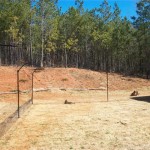









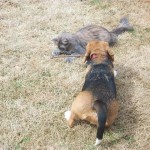

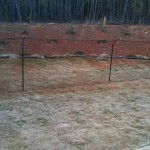
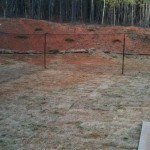


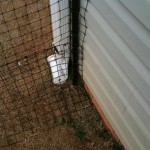

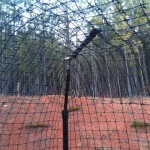
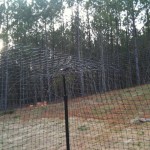
Thank you for these great instructions! I’m about to install one of the Purrfect fences today, and it was very helpful to hear about your experience. I was wondering what happened at the corners of the house, and now I know…your animals look very happy, and I’m sure they’re grateful for their new fence!
Hi Vicki,
Glad to have helped :). They are really enjoying the fence, we are thinking of extending it in the next few months; to give them some more real estate. We’ve also installed a storm door with a cat door so they can go in and out as they please.
Have fun!
Lew
We got a Purrfect fence this May and so far have had 3 escapes. We did not see how the cats got out, but when calling my cats to come back in this evening when I couldn’t find them, one of them ran and jumped up and over the fence to get back into the yard — he was being chased by a larger neighborhood cat at the time.
I bought the fence for peace of mind, but now I’m thinking of taking it down altogether.
Hi Nancy,
Are you sure it’s setup properly or there isn’t a way for them to get over it? We’ve had our fence for a couple years now and the only escape was when one of the cats jumped from the grill to the rain gutter and got on the roof of the house. We’ve even had a stray cat climb into the fence (which is easy) but then couldn’t get out of the fence when our dogs started to chase it. It was literally clinging to the top of the fence where the arms stick out and it had no place to go.
(by the way, we adopted her and she’s best friends with the dogs now)
How did you drive in the 2′ standards perpendicular to the ground? I don’t want the poles to have a noticeable lean. thanks.
Kenneth, I just eyeballed it, part of the instruction after you insert the poles into the ground is to push and pull the poles to bend them, making sure they are straight (no noticeable lean).
You indicated a maximum of 14′ spacing of poles. With 100′ of fencing, they supply only 8 poles which works out to 16.7 feet if evenly spaced. Did you space any poles at this spread? thanks, again. kj
The most we did was the 14′ maximum, but I think your math is off. You have 8 poles with 7 sections of fence. 100 / 7 = 14.3. Also, we ended up extending our fence a year later, I wrote about the experience here: http://lewayotte.com/2011/02/18/the-purr-fect-fence-revisited/
I don’t understand what you mean by 7 sections of fence. If you take away the first and last pole(attaching to wall of house, that leaves 100 linear feet to be sectioned in 6 equal parts, 100/6=16.67. I’m going to read your next link about the added fence you installed.
There are 8 poles… which means there are 7 sections of fence. Dividing by 6 is wrong (by taking away the poles) because you shouldn’t be dividing by the number of poles, but the space between the poles (i.e. 7 spaces between the poles).
| 1 | 2 | 3 | 4 | 5 | 6 | 7 |
100 feet / 7 sections = 14.2857143 feet/section
Hopefully that little text example comes through properly :).
I stand corrected. Thank you. kj